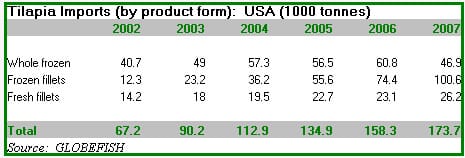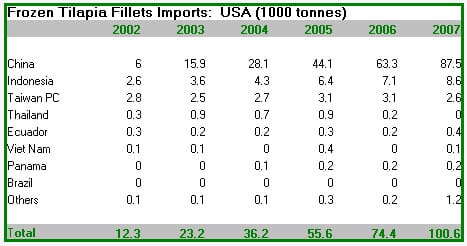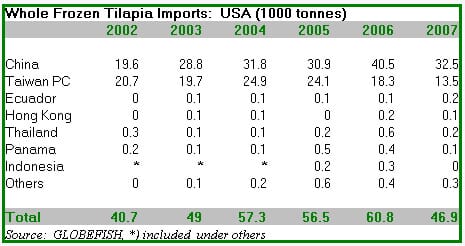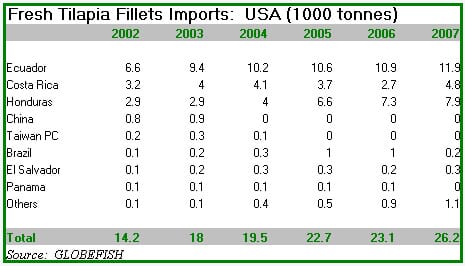Tilapia important on US market
However, the cold winter weather in recent months has wiped out large populations of tilapia in this country. It remains to be seen whether China will be able to continue to export large, and increasing, quantities of tilapia to the world market. Already the market has reacted with a 20% import price increase for tilapia in the USA.
 |
The intense and long winter is reported to have badly affected tilapia production in China. Observers estimate that production could have dropped by as much as 80%. Tilapia traders worldwide forecast a significant scarcity this year, which could last for 8-12 months. Subsequently, prices have started to rise. Chinese exports of tilapia to certain African markets may be affected until the situation improves. These developments could have a positive influence on Latin American tilapia producing countries like Ecuador, Costa Rica, Honduras and Brazil, which would be able to provide adequate supplies of tilapia, particularly fresh product, at better prices. Suppliers of marine whitefish species, many of which had been substituted by tilapia products in recent times will also be able to take advantage of the situation.
USA consumes about 400 000 tonnes of tilapia
According to the latest Consumer Price Index forecast, seafood prices in the USA are expected to rise by 2-3% this year, due to increasing production costs. A skyrocketing fuel price that reached US$109/barrel recently is the main driving factor as transporting fish has become costly. The depreciation of the US dollar also makes imported seafood more expensive. The prices of fresh seafood in wholesale markets, are expected to increase by around 10% compared to the average price recorded last summer. In addition to higher transportation costs, feed for farm-raised fish is also more expensive. To save money when buying fish, retailers advise shoppers to buy whole fish instead of fish fillets as the former is much cheaper. A fresh whole tilapia for example costs US$ 1.99/lb while a tilapia fillet costs US$3.99/lb. Besides being cheaper, whole fish also give consumers an option to save the heads and bones for making soup. Besides seafood, prices of other food products in the USA are also expected to increase by 3-4% this year.
The US market for tilapia continues to grow. Total imports in 2007 were 173 000 tonnes. Taking a conversion factor of 2.85 for tilapia fillets, this gives about 400 000 tonnes of round tilapia, the USA is thus the world’s second major market for tilapia after China. Frozen fillets expanded their share in the US market by 30%, while whole frozen is losing ground.

Chinese tilapia was excluded from FDA checks on seafood products , as apparently the species is less subject to the use of prohibited substances. As a result, exports of tilapia from China to the US market continued to grow in the second half of the year, in contrast to other seafood products. In 2007, Chinese tilapia exports reached 120 000 tonnes, 19% more than in the same period of 2006. No other supplier could keep up with the Chinese tilapia boom. However, the terrible winter weather experienced in the southern part of China wiped out large populations of tilapia. This has caused great losses in that country. Therefore, the incoming volumes of raw material into the market in early 2008 are much lower than the demand. As a result tilapia prices have started moving up in recent weeks, sometimes by as much as 20%.

Total US imports of frozen tilapia fillets reached 100 000 tonnes in 2007. China dominates this market segment, accounting for 90% of total supply. Exports of this product from China grew by almost 42% in 2007 over 2006. Indonesia is a distant second as a supplier for this product form.
Prices of frozen tilapia fillets have bottomed out, after continuous declines experienced in recent years. At present prices are increasing at a steady rate. Shortages in traditional groundfish markets combined with reduced arrivals of catfish from China and the recent winter spell create a good environment for further import price increases of frozen tilapia fillets. The larger sized frozen fillets in fact reached US$ 2.35/lb in March 2008, up from a low US$ 1.95/lb in mid 2007.

Frozen whole tilapia exports to the US market are declining. This product form used to be the dominant one in the US market only two years back, but at present, frozen whole only accounts for 27% of the total US tilapia market. China also dominates the frozen tilapia market in the USA, with an increasing share in total exports of this product to the US market (almost 70%). However, the trend is clearly for a reduced presence of whole tilapia in the market, and even Chinese exports of this product experienced an important decline.
Fresh tilapia fillets are in a different market segment altogether. Their price is almost double that of frozen fillets. Fresh tilapia goes to the restaurant trade, while frozen tilapia fillets are feeding the processing industry at the lower end of the price scale.

Latin American countries dominate this market, taking advantage of the relative proximity to the US market, which reduces shipments costs. While China dominates the frozen tilapia market, there is some interesting competition among Latin American countries to dominate the fresh tilapia supply. Mexico, though being a close neighbour of the USA, never managed to enter this market, as its production is mainly coming from capture fisheries.
In 2007 fresh tilapia fillet imports reached 26 000 tonnes, up by 15% over 2006. This was mainly due to a recovery in Costa Rican tilapia production, after the disease problems of late 2005 and early 2006. Ecuador and Honduras also reported higher exports to the US market in 2007. Fresh tilapia fillet prices went up in the course of 2007 and in early 2008. Nevertheless, some exporters of this product, such as Brazil, find a better market in their own country and have stopped exporting to the US market.
Higher prices for tilapia very likely
Due to the dramatic situation in China, tilapia prices are likely to increase sharply. Latin American countries, where tilapia production is booming, are expected to take advantage of the situation and ship increased quantities of tilapia at much higher prices to the US market. Total imports into the US market are likely to decline in the course of 2008. Demand for other fish species might be affected also, with higher prices across the board. The slow expansion of tilapia supplies to the EU market that has been observed in recent months is forecast to come to a sudden end.
April 2008

